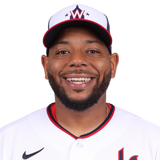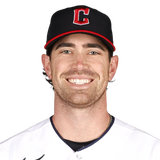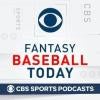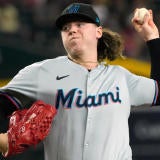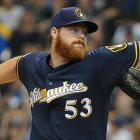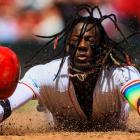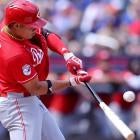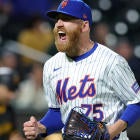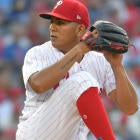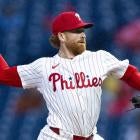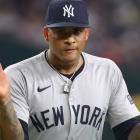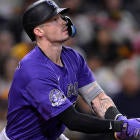Our expectations for what a 2020 season might look like are being challenged by the day, but the most feasible ideas being bandied about right now would include a 100-game schedule that begins in early July.
That's a point in the year when normally about 80 games remain, so fitting another 20 in there would take some doing. Whether they come in the form of fewer off days with regular doubleheaders or simply a later end date remains to be seen, but both possibilities appear to be on the table. It may turn out to be a combination of the two.
The condensed schedule especially would change certain behaviors within the game, some we'll see coming and some we won't. But it's important to remember amid all the speculation that these changes are entirely theoretical, which is why I'd be reluctant to go whole hog for any of them.
Note: This week's questions are brought to you by members of the Fantasy Baseball Today group on Facebook. You can become one yourself and take part in Fantasy Baseball discussions year-round.
Does the possibility of a shortened season and more compact schedule significantly decrease closer value and bump up solid hold options as teams most likely will be having multiple closers from this point on? -Matt Figliuzzi
"Multiple closers" is a big leap to make. Even qualifying it with "most likely" I think takes it too far.
Yes, playing more games over a shorter span of time would make managers more deliberate about resting their closers, but it would still be usage-driven. Most could go two or three days in a row without needing a day off, just like during a normal season, and teams generally don't go on the sort of saves streak that would require the setup man to fill in. It'll happen a couple times during the season, sure, and maybe it'll happen a couple more times during a condensed season. So often that every team effectively has two closers? I don't see it.
Maybe every team's setup man will have 2-3 more saves than in years past. Maybe for some team out there, the distribution of saves will be so bunchy that it'll have to turn to its setup man 6-7 more times than usual. It seems plausible, particularly if doubleheaders happen almost weekly. But which team will it be?
There's no predicting it, of course. Maybe at points during the season, we'll be able to say, "hey, this team's closer was needed three times over the weekend, so his setup man might be able to steal a couple saves this week." Maybe. But to anticipate months in advance when and where those moments will come is a fool's errand.
If the league adopts the DH for all teams for this season, how attractive does it make Yoenis Cespedes as a fantasy option? -Mike Dingman
I think the biggest winner for the Mets in such a scenario would be J.D. Davis, whose playing time amid his defensive shortcomings would no longer be at the mercy of Cespedes' recovery. But yes, the universal DH would mean one fewer roadblock for Cespedes.
Ultimately, though, the biggest roadblock is still the recovery itself. It's no easy path he's on after having surgery on both heels and then breaking his right ankle in multiple places.
| ||||||||||
And then there's Dominic Smith, whose bat is good enough that I think the Mets would welcome the opportunity to play the 24-year-old first baseman in the DH spot most days. The fact he bats left-handed could mean the right hand-hitting Cespedes eventually splits the role with him while also stealing some starts in left field. But barring an injury to someone else, I don't envision Cespedes playing every day. No, the pecking order would be Davis, then Smith, then Cespedes.
If there is no 2020 baseball, should your already drafted Head-to-Head points auction keeper league with $5 keeper escalator simply roll over to 2021 with no escalator, or should you select your keepers from the team as drafted and then apply the escalator? -Daniel Benjamin
I answered a version of this question just last week, but the additional wrinkle here is that your league has already drafted for 2020.
Even so, my gut reaction is still that you should leave things as-is heading into 2021. Sure, everyone will be a year older, and there will be some player movement, such as Mookie Betts signing with a new team, that might shake up the player rankings slightly. But those seem like minor trade-offs for the sake of integrity.
What I mean by "integrity" in this case is an auction where no one knew what anyone was planning to do. If Fred knew Johnny was willing to go all the way to $19 for Matthew Boyd, he might have gone those extra $3 for Trevor Bauer, which then would have changed something for Tina, and on and and on down the line. The auction wouldn't be as honest because everyone would have already tipped his hand. Again, apart from every player being a year older and a few having changed teams, nothing will have changed heading into 2021. Our valuation of most every player would be the same as it is now.
Of course, having rosters roll over with no escalator would mean no auction at all for your league in 2021, which might be a tough pill to swallow for some. Draft Day is the biggest holiday on the Fantasy calendar, and doing without it after already doing without a whole year of baseball might dampen enthusiasm beyond the point of recovery. You'll want to talk it out as a league and decide what everyone can live with.
But my vote would be to roll everything over.
Based on both of their breakouts last year, are you more confident in Jack Flaherty or Shane Bieber for the future? -Brad Detrick
Flaherty was the better prospect, and for players so young and inexperienced, that's still where the evaluation begins for me. If nothing else, it's a useful tiebreaker for players who profile so similarly.
Both Flaherty and Bieber are 24. They're just a couple spots apart in ADP, both going at the Round 2-3 turn. Both entered the Cy Young discussion for the first time last year, with Flaherty finishing fourth in the NL and Bieber finishing third in the AL. Neither is as foolproof as Walker Buehler, who has become sort of the consensus No. 1 starting pitcher target in dynasty leagues, but both Flaherty and Bieber are right behind him in that discussion.
| ||||||||||
My preference in redraft leagues is actually Bieber. He's such an efficient strike-thrower that he still has a chance to separate himself in terms of workload. His 10 starts of more than seven innings dwarfed Max Scherzer's five, Justin Verlander's four, Gerrit Cole's three and Jacob deGrom's two. But the downside is also higher. He gave up some of the hardest contact of any pitcher last year, and his xERA, according to Statcast, was an uninspiring 3.94 as a result.
It's not enough to worry me in the short term, but from a long-term perspective, it means Bieber has a tighter rope to walk than Flaherty. And maybe one of these years, the rope breaks.
| ||||||||||
Flaherty, meanwhile, had just a 3.36 xERA last year. The data supports an ace profile a little better. The concerns are there — namely that his breakthrough last year relied on a plainly unsustainable second half in which he had a 0.91 ERA — but the road to disaster isn't marked as clearly for him as it is for Bieber. In a dynasty context, that's the more important factor.
Can you do a dynasty breakdown of Brandon Woodruff? -Luke Fitzpatrick
The difference in the short-term and long-term valuation for Woodruff is stark. I don't mean like it is for Bieber. I was having to nitpick there between him and Flaherty. No, Woodruff's rises to such a level that I'd actually consider selling high on him in a dynasty league.
I credit a comment from Bryce Harper early last year for this line of thinking. Woodruff one-hit the Phillies over eight innings, striking out 10, and Harper said it was like facing Matt Harvey at his peak. He meant it as a compliment, and I took it as such. But it turns out the comparison is almost too apt. The harder I look at Woodruff, the more I see the potential for things to go just as wrong as they did for Harvey.
| ||||||||||
In fact, even more than Harvey, Woodruff relies on his fastball being a world-beater, which is fine for as long as it is one. His swinging-strike rate on that pitch is in rare company, and you may remember he shut down the Nationals for four innings in the Wild Card game throwing almost exclusively that pitch.
But he averages 97 mph on it and touches 100. How long before it loses something, especially if he's asked to be the workhorse for the Brewers staff? None of his secondary pitches is more than passable at this point, existing mostly to keep hitters off his fastball, so the decline, whenever it comes, could be a precipitous one. And with so much riding on his ability to blow that pitch by hitters, a drop of just 1 mph could make all the difference.
No one can say for sure exactly when that decline will come. Presumably not this year, which is why I still rank Woodruff high in the short term, but it's worth pointing out he's already 27.
What do you think of this scoring for a dynasty points startup (see below)? -Rob Smith
Hitting | | | Pitching | |
Single | 1 | | Inning | 1 |
Double | 2 | | Earned run | -1 |
Triple | 3 | | Walk | -1 |
Home run | 4 | | Strikeout | 1 |
RBI | 1 | | Quality start | 5 |
Run | 1 | | Win | 5 |
Stolen base | 2 | | Loss | -5 |
Walk | 1 | | Save | 7 |
Hit by pitch | 1 | | | |
Error | -1 | | | |
It just depends what kind of league you want. This setup strikes me as one that diminishes the value of starting pitchers by awarding just one point per inning instead of three, which is the CBS standard. It does make up for it some with five points for every quality start (instead of the standard three) and one point for every strikeouts (instead of the standard .5), but what you're doing there is widening the gap between the haves and have-nots at the position. The middle class is already dwindling at starting pitcher. Those changes would only hasten its demise by taking low-strikeout innings eaters like Marcus Stroman and Dallas Keuchel off the table.
Of course, the emphasis on high-end starting pitchers may still turn out to be less than in a league with standard scoring. Pitchers would be scoring less on average because of the reduced value of innings, but hitters would be scoring more since they aren't losing half a point for every strikeout.
If those consequences sound like ones you can live with or even appreciate, then by all means, proceed. CBS Sports isn't the end-all, be-all on points leagues, after all. But since 95 percent of the ones I've played in have used CBS Scoring, I can only speak in relative terms. And those changes sound to me like steps in the wrong direction.
Can Jose Berrios take a step forward toward being an ace? -Chris Clegg
He's already had so much success at such a young age that I wouldn't rule out something else clicking for him, sure. Maybe he develops a new pitch or alters his existing selection to find another gear the way Patrick Corbin has. But if Berrios just keeps doing what he's doing, I don't think the skill set supports another leap.
| ||||||||||
It's worth pointing out he has basically been the same pitcher for three straight years, with an ERA ranging from 3.68 to 3.89, a WHIP ranging from 1.14 to 1.23 and a K/9 ranging from 8.6 to 9.5. The workload has improved during that time. As he has become more efficient, he has been able to pitch deeper into games, improving his overall production marginally. But inning for inning, it has been remarkably consistent and decidedly unremarkable.
But, interestingly enough, unremarkable has become sort of remarkable at a time when mid-level starting pitchers are scarce, and Berrios' workload expectations put him at the higher end of that dwindling middle class. Of course, the same efficiency that has helped him stand out has perhaps also made him more hittable, given the drop in strikeout rate, and as uninspiring as his 3.68 ERA last year was, his 3.85 FIP, 4.32 xFIP, 4.28 SIERA and 4.03 xERA last year all suggest it could have been worse.
In a 12-team Head-to-Head categories league, what catcher would you pick up if you punted on catching? I like Danny Jansen, but I think he's going to tank my batting average. -Tim Gibbs
I'm assuming it's a one-catcher league? I'm inclined to just say "rankings!", which is like the Fantasy analyst equivalent of "scoreboard!", and pretend this exchange never happened, but I'll take the opportunity to comment on Jansen.
He's 16th in said rankings, so I obviously wouldn't be taking him in your position either. Most likely, one of Carson Kelly, Christian Vazquez, Omar Narvaez and Sean Murphy will still be there for your last pick, and they would all be preferred choices. But catchers like Jansen, as well as Tom Murphy and Francisco Mejia, demonstrate why you can afford to wait so long at the position. They all have the upside to emerge as viable starters, and anyone who already has a viable starter isn't going to make a play for them if they do.
Why not? You can't do anything with a second catcher. You wouldn't play him anywhere else he's eligible, including utility, because the overall production just doesn't compare to other positions, and you can't trade him if everyone else in the league already has a viable starter at the position. Roster space is precious, and a second catcher in a one-catcher league is just a bad use of it. So rising stars at catcher often remain untouched for longer than at other positions.
The person taking the last catcher, then, isn't just resigning himself to that one. He's freeing himself to swap out that one for any other one that emerges on waivers, with Jansen being a prime candidate based on his minor-league track record and the improvement he was showing this spring.
It's why I think two-catcher leagues get a bad rap. Sure, they may go a little too deep into the catcher pool, but one-catcher leagues don't go far enough, robbing the middle tiers of their value by presenting too attractive of a waiver wire.









